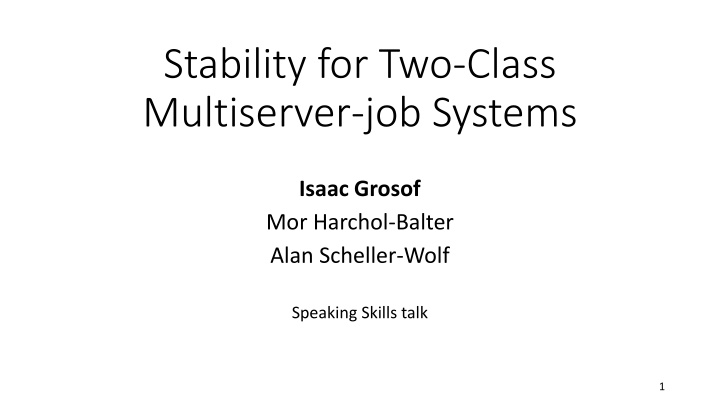
Understanding Stability in Multiserver Job Systems
Explore stability in multiserver job systems through two types of analysis: worst-case and stochastic analysis. Learn about stochastic models of data centers, parallel job models, and the vital question of stability and throughput. Gain insights into waste, prior results, and an elegant analytical framework for saturated systems.
Download Presentation

Please find below an Image/Link to download the presentation.
The content on the website is provided AS IS for your information and personal use only. It may not be sold, licensed, or shared on other websites without obtaining consent from the author. If you encounter any issues during the download, it is possible that the publisher has removed the file from their server.
You are allowed to download the files provided on this website for personal or commercial use, subject to the condition that they are used lawfully. All files are the property of their respective owners.
The content on the website is provided AS IS for your information and personal use only. It may not be sold, licensed, or shared on other websites without obtaining consent from the author.
E N D
Presentation Transcript
Stability for Two-Class Multiserver-job Systems Isaac Grosof Mor Harchol-Balter Alan Scheller-Wolf Speaking Skills talk 1
Two Types of Analysis This talk Worst-case Analysis Stochastic Analysis Adversarial Inputs How does this algorithm perform on its worst-case input? Random Inputs How well does my algorithm perform on average? Very general Results about averages Typical behavior in practice may not resemble worst-case behavior More realistic setting Can reveal practical insights 2
Stochastic Models of Data Centers FCFS ordering Traditional Multiserver Model: M/G/k i.i.d. job duration distribution Identical Servers Poisson process with arrival rate k Q: Why does one- dimensional job model no longer resemble data centers? A: Many jobs now parallel. 3
Parallel Job Model 4 3 # servers required 2 1 3.2s 4.1s 5.5s Job duration 4
Modern Model: Multiserver Jobs i.i.d. joint distribution of (# of servers, duration) Duration # servers Closely resembles modern datacenters, e.g. Google s Borg scheduler [Tirmazi et al. 20] 5
Vital Question: Stability/Throughput Stable: Queue stays short doesn t explode in length. Q: Maximum stable arrival rate? (i.e. max throughput?) Multiserver-job M/G/k ? ? < Waste: # empty servers despite jobs in queue ?[????????] ? < ??? ??[????????] < ? Rate work is completed Rate work arrives 6
Outline Introduce multiserver-job model Introduce stability problem Discuss waste Prior results on stability Introduce our specific model Key idea: Saturated System Elegant analytical results Insights from results 7
Waste Understanding stability Understanding average waste Key question: What fraction of time in each scenario? 8
Prior Results on Multiserver-Job Stability Past results: Brill & Green 84, Filippopoulos & Karatza 07: - Two servers - Single duration distribution, independent of # of servers Our result: Arbitrary # of servers Jobs requiring different #s of servers have different job size distributions. Specifically: 2 job classes. Rumyantsev & Morozov 16: - Arbitrary # of servers - Single duration distribution, independent of # of servers First model to handle correlation between # of servers and duration. Real data centers: # of servers and duration are correlated by default. 9
Contributions Derive first analytical formula for stability for the two-class multiserver-job model. Introduce a novel technique for analyzing multiserver-job systems: Saturated System. 10
?? i # servers Two-class Model Specifics Exp(??) Duration 1 2 1 1 2 2 2 # servers required Service duration Prob. ?2= 1 ?1 w.l.o.g.: ?1< ?2 Exp(?1) ?1 Job requirements distribution: ?1 ?2 ?2 Exp(?2) 11
Outline Introduce multiserver-job model Introduce stability problem Discuss waste Prior results on stability Introduce our specific model Key idea: Saturated System Elegant analytical results Insights from results 12
?? i # servers Example of system evolution Exp(??) Duration Setting: ?1= 2,?2= 3,? = 14 2 1 2 2 2 1 4 Servers can be saturated 3 # class 2 in service 2 1 0 7 3 4 5 6 0 1 2 # class 1 in service 13
?? i # servers Example of system evolution Exp(??) Duration Setting: ?1= 2,?2= 3,? = 14 2 1 2 2 1 1 1 1 2 2 4 Servers can be saturated 3 # class 2 in service 2 1 0 7 3 4 5 6 0 1 2 # class 1 in service 14
?? i # servers Example of system evolution Exp(??) Duration Setting: ?1= 2,?2= 3,? = 14 2 1 2 1 1 1 1 2 2 4 Servers can be saturated 3 # class 2 in service 2 1 0 7 3 4 5 6 0 1 2 # class 1 in service 15
?? i # servers Example of system evolution Exp(??) Duration Setting: ?1= 2,?2= 3,? = 14 2 1 2 1 1 1 2 2 4 Servers can be saturated 3 # class 2 in service 2 1 0 7 3 4 5 6 0 1 2 # class 1 in service 16
?? i # servers Example of system evolution Exp(??) Duration Setting: ?1= 2,?2= 3,? = 14 2 1 1 1 1 1 1 1 2 2 4 Servers can be saturated 3 # class 2 in service 2 1 0 7 3 4 5 6 0 1 2 # class 1 in service 17
?? i # servers Example of system evolution Exp(??) Duration Setting: ?1= 2,?2= 3,? = 14 2 1 1 1 1 1 1 1 1 1 2 4 Servers can be saturated 3 # class 2 in service 2 1 0 7 3 4 5 6 0 1 2 # class 1 in service 18
?? i # servers Example of system evolution Exp(??) Duration Setting: ?1= 2,?2= 3,? = 14 2 1 1 1 1 1 1 1 2 4 Servers can be saturated 3 # class 2 in service 2 1 0 7 3 4 5 6 0 1 2 # class 1 in service 19
?? i # servers Example of system evolution Exp(??) Duration Setting: ?1= 2,?2= 3,? = 14 2 1 1 1 1 1 1 1 2 4 Servers can be saturated 3 # class 2 in service Key insight: Only states with saturated servers matter for stability 2 1 0 7 3 4 5 6 0 1 2 # class 1 in service 20
Defining the Saturated System Saturated System: only include states where no more jobs can enter service. More jobs are always available. State descriptor: [Blocking job?, # class 1, # class 2] Blocking job 1 1 1 1 2 1 1 1 1 2 2 2 1 1 1 1 2 2 2 2 2 2 2 [0, 4, 2] [0, 5, 1] [1, 0, 4] [1, 3, 2] 21
Our Saturated System Theorem Let ? = sup {Original system is stable with arrival rate ?} ? i.e. system is stable if ? < ? , and unstable if ? > ? . Theorem: ? = Throughput of saturated system. Saturated system Original system 22
Zoomed-in Outline Goal: analyze stability in original system To do so: Analyze saturated system 0 , 7 , 0 0 , 5 , 1 Detailed structure of Saturated State Space 0 , 4 , 2 1 , 3 , 2 0 , 2 , 3 0 , 1 , 4 1 , 0 , 4 Elegant analytical result 23
Saturated State Space Structure Properties of all 2-class MSJ systems: 1. Exactly one state w/ ? class 1 jobs: ?1? 1,0,4 0,1,4 0,2,3 ?: # class 2 in service 0,4,2 1,3,2 0,5,1 ?13 1,6,0 0,7,0 ?: # class 1 in service 24
Saturated State Space Structure Properties of all 2-class MSJ systems: 1. Exactly one state w/ ? class 1 jobs: ?1? 2. Exactly one state w/ ? class 2 jobs and no blocking job: ?2(?) 1,0,4 0,1,4 0,2,3 ?: # class 2 in service ?23 0,4,2 1,3,2 0,5,1 1,6,0 0,7,0 ?: # class 1 in service 25
?? i # servers Our Steady State Result Let ?1? = Pr{Next job to complete is class 1 | start in state ?}. ?2? same for class 2 jobs. ?1 ,?,? = Exp(??) Duration ??1 ??1+??2, ?2? = 1 ?1? . (easy to show) ?2: probability arriving job is class 2. Theorem: Saturated system steady state distribution* is ? ? ?1 ?2 ? ?[?,?,?]= ??2 ?1(?1? ) ?2(?2? ) ?: Normalizing constant ?=1 ?=1 ?1(?): probability next completion from s is class 1. ?2? : state with exactly ? class 2 jobs and no blocking job ?1? : state with exactly ? class 1 jobs 26 * Specifically, steady state of the embedded chain.
Our Stability Result Q: For what arrival rates is the original system stable? Analytical expression for boundary of stability, ? Analytical expression for Saturated System throughput Analyze Saturated System throughput Product-form steady-state expression for Saturated System 27
Outline Introduce multiserver-job model Introduce stability problem Discuss waste Prior results on stability Introduce our specific model Key idea: Saturated System Elegant analytical results Insights from results 28
?? i # servers Insight: Average Waste can be High Exp(??) Duration Setting: ?1= 1, ?1= 2, ?2= 200, ?2= 1, ? = 200 1 Idealized stability region without waste 0.8 0.6 0.4 0.2 Analytically-derived stability region Arrival rate of class 2 jobs: ??2 Loss due to waste 0 0 100 200 300 400 Q: Why so much waste? Arrival rate of class 1 jobs: ??1 29
?? i # servers Insight: Waste can be Nonmonotonic Exp(??) Duration Setting: ?1= 1, ?2= 67, ?1= ?2= 0.5, ? = 201 100% 80% Average waste, relative to max. possible waste 60% 40% 20% 0% 10-4 10-2 1 102 104 Class 2 slower Same duration Class 1 slower Relative class durations (?2/?1) 30
Conclusion & Future Directions Derived analytical formula for stability for two-class multiserver-job systems. Proof based on saturated system, gives beautiful product-form result. Theorem: Steady state distribution is Open problems: Can we go beyond 2 classes? Can we go beyond stability? Can we go beyond FCFS? Are there more product form solutions out there? ? ? ?1 ?2 ? ?[?,?,?]= ??2 ?1(?1? ) ?2(?2? ) ?=1 ?=1 pause 31
Backup: Saturated Original Proof Sketch Thus, If Saturated System s throughput > , stable. 32
Backup: Other prior work Dropping multiserver-job model: Fully general solutions by Arthurs and Kaufman 79, Whitt 85, many more. General scheduling (not just FCFS): Convex hull of all packings, by Maguluri et al. 12, many more. 33
Backup: Proof Sketch: Stationary Equations Need to show: 1,6,0 0,7,0 ?? ? ? ,? ?,??= ? 0,5,1 where ? ?,? is the probability that state y transitions to state z. 1,3,2 0,4,2 0,2,3 1,0,4 0,1,4 34
Key Idea: Decomposed Stationary Equations Show instead: ?? ?1? ,? ?,?1??= 1,6,0 0,7,0 ? ?? ?2(? ,?) ?,?2??= 0,5,1 ? where ?1?,? is the probability state y transitions to state z after a class 1 completion. 1,3,2 0,4,2 0,2,3 1,0,4 0,1,4 35






















